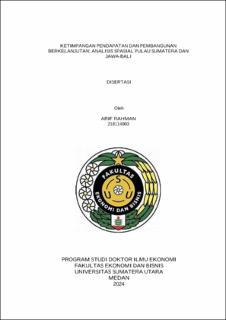| dc.description.abstract | This study aims to examine the income and welfare inequality gap and detect convergence of inequality among provinces in Sumatra and Java-Bali. This study also aims to examine the direct, spillover, and mediating effects of the determinant variables on inequality. The observation period of the study is from 2015 to 2022. The study uses panel data sourced from the Central Bureau of Statistics, Ministry of Environment, and Ministry of Finance. The results prove that there is a relatively low level of income inequality among provinces in Sumatra Island, followed by a relatively low welfare gap among provinces. The study in Java-Bali Island shows the same thing in terms of income inequality, with a relatively lower gap compared to Sumatra Island, but with a more unequal level of interprovincial welfare. This study also detects a convergence of income inequality in Sumatra and Java-Bali. The study in Sumatra Island proves that improvements in environmental quality, real GDP per capita, and the distribution of highly educated labor can reduce income inequality in the observed province, which in turn leads to a reduction in inequality in the surrounding provinces. Meanwhile, increasing population density has positive direct and spillover effects. The Java-Bali study shows that an increase in real GRDP per capita reduces income inequality in the observed provinces. An increase in the number of highly educated workers and population density will increase inequality in the observed provinces. The study in Sumatera Island shows that an increase in population density will increase real GRDP per capita, which in turn will reduce inequality. Meanwhile, regional expenditure per capita is able to reduce income inequality through an increase in real GRDP per capita. Neither environmental quality nor real GDRP per capita has a mediating effect in the case of Java-Bali Island. | en_US |


